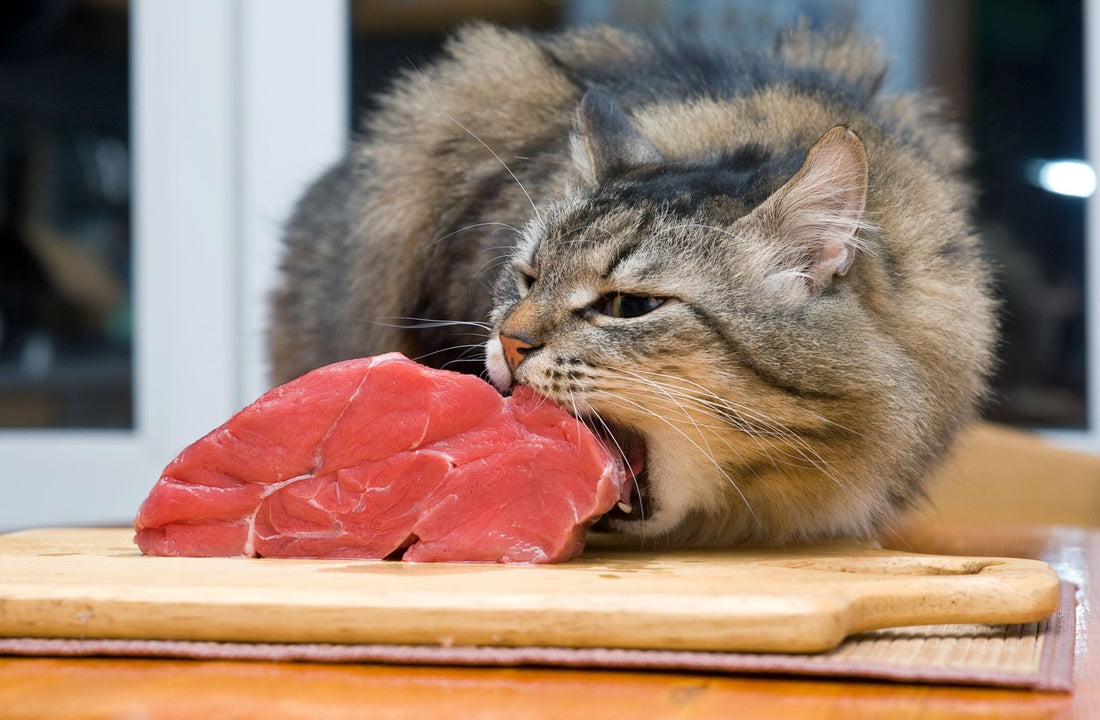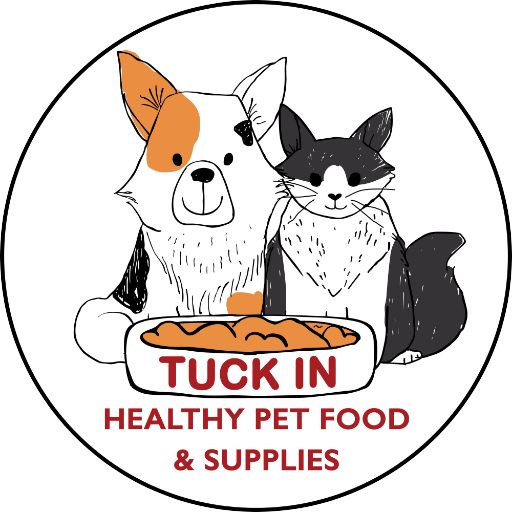
Raw Feeding for Kittens and Cats
Share
Raw feeding is a way of providing your cat with a diet that is similar to what they would eat in the wild. It consists of uncooked animal products, such as muscle meat, organ meat, and bones. Raw feeding is based on the idea that this is the most natural and biologically appropriate way of feeding your cat, and that it can offer many health benefits.
In this article, we will explain:
- Why raw feeding is good for your cat
- What are the essential components of a raw diet
- How to switch your cat to a raw diet
- How to prepare and store raw food safely
Why raw feeding is good for your cat
Cats are obligate carnivores, which means they need animal protein and fat to survive and thrive. They have evolved to digest and utilize raw meat efficiently, and they have little ability to process carbohydrates, grains, and plant matter. Their natural diet consists of small prey animals, such as rodents, birds, and insects, which provide them with all the nutrients they need.
However, most commercial cat foods are far from mimicking this natural diet. They often contain low-quality meat, by-products, fillers, additives, and synthetic vitamins and minerals. They also undergo high-temperature processing, which destroys some of the nutrients and enzymes in the food. These factors can compromise your cat’s health and well-being, and lead to various problems, such as:
- Obesity and diabetes
- Dental disease and bad breath
- Urinary tract infections and crystals
- Kidney and liver disease
- Allergies and skin issues
- Digestive disorders and hairballs
- Arthritis and joint pain
- Behavioural problems and stress
Raw feeding, on the other hand, can help prevent or improve these conditions, and provide your cat with many benefits, such as:
- Lean and muscular body
- Healthy teeth and gums
- Clear and shiny coat
- Strong immune system
- Optimal hydration and urine pH
- Reduced stool volume and odor
- Enhanced energy and vitality
- Increased mental stimulation and satisfaction
What are the essential components of a raw diet
A raw diet for cats should be balanced and complete, meaning that it should provide all the essential nutrients that your cat needs in the right proportions and forms. Raw diets are based on replicating the prey animals that cats would eat in the wild, such as mice, rats, rabbits, and birds. These prey animals are composed of roughly 80% muscle meat, 10% bone, 5% liver, and 5% other organs. Therefore, a PMR diet for cats should follow the same ratio, and include the following components:
- Muscle meat: This is the main source of protein, fat, and water for your cat. It also provides essential amino acids, such as taurine, which is vital for your cat’s heart, eyes, and brain. Muscle meat can come from various animals, such as chicken, turkey, duck, rabbit, lamb, beef, venison, etc.
- Bone: This is the main source of calcium and phosphorus for your cat, which are essential for their bones, teeth, and nerves. It also provides other minerals, such as magnesium, potassium, and zinc. Bone can come from the same animals as muscle meat, but you should choose small, soft, and edible bones, such as ribs, necks, wings, feet, etc. You should avoid large, hard, and weight-bearing bones, such as femurs, knuckles, etc., as they can splinter and damage your cat’s mouth, throat, or intestines. You should also avoid cooked bones, as they become brittle and dangerous. The easiest way to provide bone in your cat's diet is to feed a pet food mince that includes the appropriate amount of ground bone in the mix.
- Liver: This is the main source of vitamin A for your cat, which is important for their vision, skin, and immune system. It also provides other vitamins, such as B12, C, D, E, and K, and minerals, such as iron, copper, and selenium. Liver can come from the same animals as muscle meat and bone, but you should choose fresh and high-quality liver, as it can accumulate toxins from the environment. You should also limit the amount of liver, as too much vitamin A can be toxic for your cat.
- Other organs: These are the main source of vitamin B for your cat, which is essential for their metabolism, nervous system, and blood. They also provide other vitamins, minerals, and enzymes. Other organs can include kidney, heart, spleen, pancreas, lung, etc. They can come from the same animals as muscle meat, bone, and liver, but you should choose fresh and high-quality organs, as they can also accumulate toxins from the environment. You should also vary the types of organs, as they have different nutritional profiles.
How to switch your cat to a raw diet
Switching your cat to a raw diet can be challenging, especially if your cat is used to eating dry or canned food. Cats are creatures of habit, and they can be very picky and stubborn about their food preferences. However, with patience, persistence, and creativity, you can successfully transition your cat to a raw diet. Here are some tips to help you:
- Start slowly and gradually. Don’t switch your cat to a raw diet overnight, as this can cause digestive upset and rejection. Instead, introduce raw food gradually, by mixing a small amount of raw food with your cat’s current food, and increasing the proportion of raw food over time. You can also offer raw food as a treat or a topper at first, and then as a separate meal. The transition can take from a few days to a few weeks, depending on your cat’s acceptance and tolerance.
- Choose the right raw food. Some cats may prefer certain types of raw food over others, depending on their taste, texture, and smell. You may need to experiment with different kinds of raw food, such as chicken, turkey, rabbit, beef, etc., and different forms of raw food, such as ground, minced, chunked, or whole. You can also try different temperatures of raw food, such as cold, room temperature, or slightly warmed. You can also add some water, broth, or gravy to the raw food, to make it more moist and palatable.
- Make the raw food more appealing. Some cats may need some extra incentives to try raw food, such as adding some flavor enhancers, such as salmon oil, egg, bone broth, etc. You can also sprinkle some freeze-dried treats on top of the raw food, to entice your cat. You can also play with your cat before feeding, to stimulate their appetite and hunting instinct. You can also use a puzzle feeder, a toy, or your hand to present the raw food, to make it more fun and interactive.
- Be consistent and positive. Don’t give up if your cat refuses to eat raw food at first, as it may take some time for them to get used to it. Don’t force your cat to eat raw food, as this can create a negative association and stress. Don’t leave the raw food out for too long, as this can spoil and attract bacteria. Don’t scold or punish your cat for not eating raw food, as this can make them more resistant. Instead, be patient and supportive, and praise and reward your cat for eating raw food, to reinforce their positive behavior.
How to prepare and store raw food safely
Preparing and storing raw food for your cat requires some care and hygiene, to prevent contamination and spoilage. Here are some guidelines to follow:
- Buy fresh and high-quality raw food from reputable pet food stores. You can buy frozen or freeze-dried raw food, which are convenient and safe options.
- Wash your hands, utensils, and surfaces before and after handling raw food, and use separate cutting boards and knives for raw food and other foods.
- Cut the raw food into appropriate sizes for your cat, depending on their preference and ability. If feeding minced frozen food or freeze-dried food you can mix it with warm water or broth to form a consistency similar to a tinned feed making it easier to eat and digest. You can also add some supplements such as the My Beau vitamin mix to enhance the nutritional value of the raw food.
- Store the raw food in airtight containers or freezer bags, and label them with the date and contents. You can keep the raw food in the refrigerator for up to 3 days, or in the freezer for up to 6 months. You can also use a vacuum sealer, to extend the shelf life of the raw food.
- Thaw the raw food in the refrigerator overnight, in cold water for a few hours, before feeding. It is often recommended not to use a microwave as it can cook raw food if not carefully watched. If you are using a microwave, use the defrost setting and be ready for some trial and error until you find the right power and time required to thaw without cooking.
- Once thawed, don’t refreeze the raw food cannot safely be refrozen so you'll want to be sure to only thaw enough for 3 days.
